|
HU RENYI: Suzhou through the prism of modernity
by Michèle Vicat
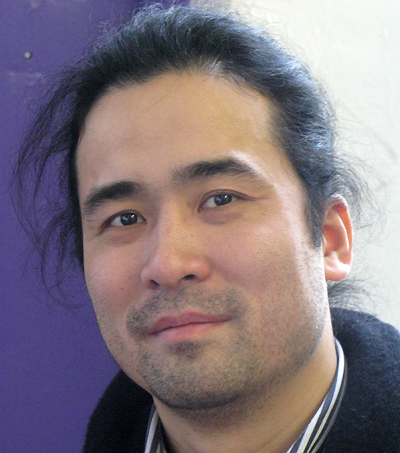
Hu Renyi, photograph © Michèle Vicat
|
Hu Renyi’s paintings capture the affinities between the architecture and the classical gardens of his native city, Suzhou, and his memories of growing up at a time when he could absorb tradition, history and the accelerated changes that were taking place. Rather than sink into melodramatic nostalgia, the artist invites us inside the subtle eurythmy between the earth and the sky.
Suzhou, as Hu Renyi describes it, is black, grey and white. Given that fact, one might be surprised to see the primary colors that the artist uses in his compositions. It could be a projection of his youthful exploration of the new temples of fast food, the vibrations emanating from western pop music, and the acceleration of visual stimuli from the first video games.
Far beyond simply creating a miniature representation of the natural environment outside, Chinese gardens encapsulate in a few elements the sense of the world around us. In the same way, Hu Renyi’s images go to the essential : shapes and colors lead us into a world that gives us the freedom to recover our own memories.
In Hu Renyi’s vision, the heavily charged contours of stones, the complex wooden and stones carvings, the luxurious vegetation are stripped down into the essential lines, which take us to the quintessence of history and the perpetual transformation of nature and its relationship to humanity. In a certain sense, Hu Renyi has become the master of a pictorial haiku by placing us as actors between these two lines, which simultaneously mark the separation between history and the future. When Hu Renyi places a person at the edge of a roof, the magic begins to operate. The contemplation of the full and the emptiness becomes a punctuation mark, a moment of reflexion, a dream to which the artist invites us while he remains out of sight behind his own landscape. We have the feeling that he is watching his little people, irreverent and mischievous who do not want to miss anything of the world that spreads in front of them.
We interviewed Hu Renyi at the School of Visual Arts in New York. The interview focused on his paintings and their relationship to architecture and landscape. Lately, the artist has been exploring the use of other materials in three-dimensions.
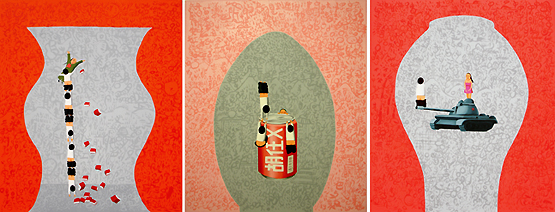
Hu Renyi's "Memory 2" (detail), oil on linen, 2008, courtesy of the artist |
Where do you come from in China?
I was born in Suzhou. It is about 80 kilometers from Shanghai.
Does your family come from that region?
No. My father’s family is from Shanghai. After 1949, my father and mother escaped from Shanghai. They tried to go to Taiwan. Their plan did not work out, and they went to Suzhou because they had friends there. The communists were acting like capitalists. My father’s family had to sell their house and even the furniture to be able to go to Suzhou. My grandfather, after having sold the house, the furniture and his company, one of the biggest lumber companies in Shanghai, decided to stay in Shanghai and to become a worker to make a little more money. The rest of the family went to Suzhou. My family was separated.
My mother’s family came from Wuxi. The town is called Dingshan. It is a famous center for ceramics in China. They make teapots there and my family had two factories. After the new China was born, the industry was finished. My grandparents died, because they got sick and they did not have any money to pay for a doctor.
Does your family have an artistic background?
Yes. My father is a traditional Chinese painter. He is also a calligrapher and a writer. He was determined to give me an artistic education and he taught me traditional Chinese methods for two years, from the age of seven to nine. Then we stopped. We discussed that. I decided to go to western classes to learn the western way of painting. I was nearly nine years old when I decided to take that path. I was fascinated by the way western artists could paint reality. Their way is different from ours and I wanted to learn it.
Besides your father’s teaching, were there other influences?
Each city was divided into different districts and each district had a government department for culture oriented to children. When I was 6 years old, I would go there during the weekend.
So, it is from an early age that you decided to become an artist?
I did not decide to become an artist at that age. I chose to learn what I liked. At that time, I did not know that the profession of being an artist even existed. Communist ideology was still promoting the farmers and the workers.
Where did you study art, in Suzhou?
I started in Suzhou and at the same time my father taught me at home especially for the classical Chinese theories. Afterwards, I went to Shanghai Teacher’s University for my college education.
I studied oil painting. That is the technique that I wanted to develop, but, to be honest with you, I really did not know which medium to chose. To enter a university, they check your mathematics scores as well as your English. Our choices depended on our scores. The major problem is that too many people apply, and the government controls everything.
Is this the same system today or do you see more flexibility?
There is a better choice in the schools today, but at that time it was different. The government decided which students could go to which schools. Everything depended on your profile, mainly in mathematics and physics. It was not fair to people who wanted to study art.
Besides the technique of oil painting, what else did you get from your studies?
I would say music, because I was playing in a band. I played base and I sang. The music gave me a feeling for art. Suddenly, I could open my mind: you can use different mediums to open your art. You do not have to focus on oil painting. Playing western music taught me a lot about freedom. You know, Chinese people live on history. They cannot live without history. Music gave me other ways of looking at art. It helped me to develop my feelings.
Even if my father was open, he taught me in a very traditional way based on history.
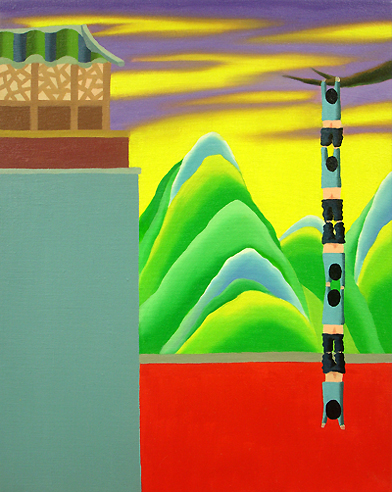 Hu Renyi's "Brothers", oil on linen, 40 x 50cm, 2008 Hu Renyi's "Brothers", oil on linen, 40 x 50cm, 2008
courtesy private collection
|
But you do not think that history and tradition are the foundation of learning?
It depends on how you look at it. Some artists want to mix tradition with contemporary art. Other artists do not want to have anything to do with tradition. When I was in college, I did not want to have anything to do with tradition. I was 19 years old and I found that it was cool to be against tradition. For example, the only music we were allowed to hear was communist music. But when I heard Shostakovich and Rachmaninoff, it suddenly opened my mind. The instruments are different and the tone is different. Chinese music has only five tones. Listening to an array of possibilities, I realized that that was what I wanted to do. In my second year in college, I decided to become a musician. I practiced music everyday, even in painting class and my teacher became upset. He did not understand why I was doing that. In his class, I should have learned the techniques of oil painting, but I was practicing music. Even the students became upset. Little by little, I realized that music was extremely demanding and that it was not the vehicle to achieve my artistic goals. I played in a group and I realized that two to three people at least were needed to have a band, a real band. You need people at the same level. It is extremely difficult to achieve that. I talked with the people in my band, but it did not really work. So, I went back to painting.
During your four years of college, did you have a goal to come to the West?
Yes, I really wanted to get out of China. Very much. It is funny because all I studied was based on western style, on western culture. I wanted to meet my second ancestors. After college, I did not know if I wanted to get a masters degree or not bothering with that. I continued to take some classes afterward in order to make a decision. Then, I realized that the Chinese system reproduces at a masters level what a BFA does. It was a repetition and I got really upset. So, I decided to do my own homework and learn by myself. The idea to get out of China grew then.
I am from Suzhou, which is very famous for its canals and gardens. It is a city I really love. I am really into that city. You see, in China, you can get any DVD, any book on anything, because we do not have copyright. You may even find more available information in China than in the West. If you go to Beijing in the 798 district and you want to find books on Dali, you can find quite a lot of books there, because they have books from everywhere and they also publish themselves. It is not legal, but that gives people a chance to know and learn. But, on the other hand, the entire climate changed in China during 2000-2001. It was suddenly possible to get a lot of western things in China. Then why to go to the West? It was no longer my priority. I could start to accomplish things by myself within the Chinese environment. I decided to stay in the South, in my studio with my books and my CDs. The studio was not big, may be 10 by 10 meters. But, it felt great. I did not even go out of the studio much.
What was the style of your first paintings?
I was quite influenced by the gardens and the architecture of the place where I lived. I mixed human figures with my own dream of the gardens in Suzhou . The gardens there are different from the ones in Beijing or even the ones in the South of China. There are not many colors. They are based on black, white and grey. Myself, I like colors, I like to use different colors. I use different colors to free my imagination when looking at these gardens. I also like to have people inside the painting interacting with the composition.
These paintings were also the expression of my childhood. When I was a child, we used to go often to the gardens. Much more than today, because now you have to pay to go to each garden. The local government needs the money. Before, these gardens were private. Getting older and older, I cannot see these gardens like I used to see them when I was a child. I do these paintings based on my memory.
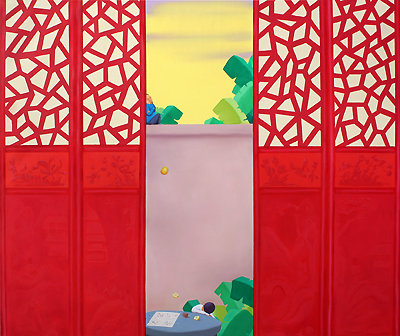 Hu Renyi's "Game", oil on linen, 106.5 x 127 cm, 2010 Hu Renyi's "Game", oil on linen, 106.5 x 127 cm, 2010
courtesy of the artist
|
What do these gardens mean to you?
They make me feel very peacefully and closer to heaven. Suzhou is a very peaceful place and you can actually see the earth and heaven when you walk in these gardens. They have an effect on people’s behavior. As a child, I do not remember people fighting each or screaming at each other. People may have had different opinions, but they expressed them in a non-aggressive way. In Suzhou, people do not like the manners of the people in the North.
Not only is it a peaceful place, but it is also thick with history. Some people consider that Suzhou is one of the cities in China with the oldest history. People did not destroy the city walls like in Beijing. People live the same way generation after generation. People also live very much with their history.
What the people are doing in your paintings?
There are buildings in my paintings. They are very structured because of that. You can follow lines in my paintings. The architecture plays a great role and I want a balance in my paintings. I do not want to create conflict inside my paintings and with the architecture. Humans can act to brake the structure of the buildings. But this is not what I want. This is not the way I was raised.
I also paint from my own experience: it is me in these gardens, it is my feelings there. My early paintings are very close to my childhood experience.
Your subjects back then were already like the ones you depict today?
I do not use models. The figures come straight from my mind. From the beginning, I did not want to use the classical way of painting based on representing a model. I experimented, but the subjects have to be in touch, in agreement with the architecture.
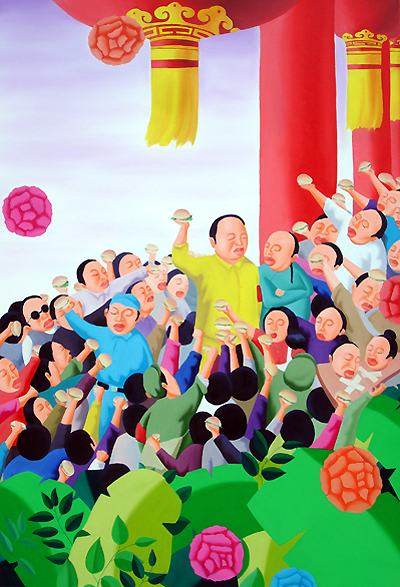 Hu Renyi's "Hamburger_Hamburger_Hamburger", oil on linen, Hu Renyi's "Hamburger_Hamburger_Hamburger", oil on linen,
152.4 x 86.4 cm, 2007, courtesy of the artist
|
Were you influenced by cartoons?
I was influenced by a lot of things. When I grew up, it was in the late 1970s, early 1980s. That was my childhood. At that time, China was starting to open to the west and the world. This continues today. The big difference between our generation and the older artists, is that we have had a greater experience of the outside world. We had new video games coming to China. I most probably belong to the first generation, which used and enjoyed these games. My cousins who belong to the beginning of the 1970s were already too old to play these games. They looked at the games, but they could not enjoy them. They could not get into them. We also had Japanese robot games. For me, I was the right age. Also, when I was may be 12 or 13 years old, McDonalds and KFC arrived in China. I was a teenager, the first generation of teenagers who experienced that. People younger than me did not have the money and people older than me did not want to experience that. I was the right person for that market because of my age! I would take girls to these place to experience the new, the west, another flavor. My mother only tasted a fried chicken from KFC once and this is only because I brought it back home and told her to taste it. Then the TV. I am most probably the first generation who saw commercial television in China. This had a great impact on us. At school, we played commercials, we created commercials. The first Monkey King Story was a TV series. We played these monkey kings in school. We were the first generation who could enjoy things, many things. We grew up with these options like the kids in America. I do not even think that young people in Europe experienced that at that time. For us, it was like “Hey, KFC opened yesterday, let’s go there.” Yesterday, we used to use a ticket that was issued by the government. We used that ticket to get rice for free. It was really like that. Yesterday, we used a ticket and tomorrow we tried KFC.
So, for my generation, we had choices, and we could experiment with them. It is even difficult for me to go through a list, because we experimented with so many things. And that came very fast. I had nothing when I was a young kid and suddenly all the choices were there. We did not even have a bathroom in my home. We had a wooden bucket as a toilet. My grandparents had a well and I used to go to the market with my parents with a ticket to buy food. We used tickets instead of money. Then tapes and then CDs came in Cantonese with pop music. When I was 17, I could only find one place to buy western music. After that, it went so fast. We had the first music of Michael Jackson. We are the first generation to listen to music like that. Everything was very mixed up.
So why the United States?
Mainly because of my wife who is American. We met in China and then she became pregnant. She did not want to have the baby in China. For me, it was difficult, because of the Green Card issue. Right now, I would like to go back to China. I like New York very much, but it is a conflict for me. I like to be in China, in Suzhou, because I can speak to the city. I can speak to my country too. Here it is a different feeling. My childhood is based on oriental history and I really do not feel New York as an inspiration for my own art. I enjoy the city and I certainly enjoy the creation of other artists who live here. In China, I can communicate. It is not only a question of verbal language. It is more an emotional communication with the city.
Western culture did not affect you?
For older generations of Chinese artists who had to leave the country, it is a different story. They left China and they did not experience western culture in China. This is completely different for me and my generation. For them, it is a question that they came here and they could absorb what they did not experience in China. In China, I heard western music as much as Americans do. People here are amazed about my knowledge of music. If I say that I love Jimmy Morrison, people here wonder how I know him. They look at me as a Chinese coming from a communist country. When I came here, I had already read a lot of western resources in China, books on Dali, Picasso. I had seen a lot of western movies. I had experienced fast food. You know, in China, your parents or grand parents always insist that you go to the place where your ancestors come from. When I came to New York , I had the same impression. I was going to visit my ancestors, my second ancestors. I felt that somehow the roots of my culture were here.
Now, I have my own family here: my wife and we have a child. But, when I go to Suzhou, I also feel that I am going to my family, meaning to my roots. When I go to Beijing, I do not have the same feeling. You know, China is very diverse. It is like Europe. We have different languages, different cultures, different architectures. Suzhou is my home. It is a question of communication and love.
But you paint here?
I have a studio here. I am very private. I rarely go to openings, museums, art galleries. I do not really enjoy this kind of social networking. I do not like the feeling of people telling me “nice to meet you” while having a glass of wine in their hand. I like to meet friends, to meet with other artists, to share my ideas with you, so we can communicate interesting ideas.
Looking at your paintings today, we are first attracted by the vivid colors. What influenced you?
My ideas come from Suzhou. My colors are not like Suzhou. Suzhou is white, grey and black. I think that I was mainly influenced by western modernism, Chagall, Mondrian, especially by Mondrian’s books, where he explains how colors communicate. That has become one of my main sources of inspiration. The combination of yellow and red is about balance, about science. His color grid inspires me. I also learn that it is not only a question of combination. You can actually squeeze the color from a tube and use it as such. You have the direct richness there. I was not doing that before. Today, I am teaching and I tell my students to buy the maximum numbers of colors they can get and try them, do not mix them, see the effect. If you buy different brands, a raw color won’t be the same. You have to experiment and discover. You have variations in colors. I even use colors that I bought more than 10 years ago. I use a little bit at the time.
What is the meaning of the small figures in your paintings ?
That is pop. They are simplified shapes from my work in calligraphy. I learned calligraphy from my father and also from my teachers in art school. I copied a lot of calligraphy from books too. The figures became my own vocabulary. It is like calligraphy though I do not like to have my work assimilated to calligraphy. I work with images and there are images inside the images.
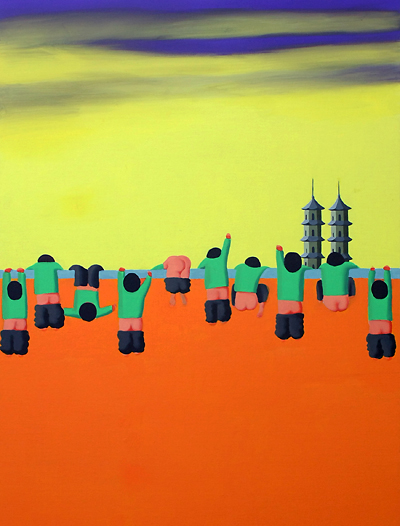 Hu Renyi's "Life is Continuing" (detail), oil on linen, 69 x 150 cm Hu Renyi's "Life is Continuing" (detail), oil on linen, 69 x 150 cm
2009, courtesy of the artist
|
What do you want to express with your paintings? Are you commenting on China? On life in general?
Nothing! I do not want to express anything. I want to do things my way. It is like music. When you listen to music, you enjoy the time. For me, being in my studio and painting is enjoying the time. I think that many artists express their feelings or ideas after the painting is done. As artists, we cannot calculate, we cannot imagine what will be on the canvas at first. It is not an exact science. We do not know what would be the right color, what would be the right expression. It is while we are working that things take shape. For most artists, it is spontaneous and the structure comes with time. It is like a travel log. You go to different countries and then you come back. You can say this is the food they like there and then you become tired, because you have already had the experience. You have to discover something else from your travels. For me, it is the same. For example, I want to paint this wall green, but if it does not work, I can change it. I do not have to deal with what I started with. I can change. I continue like that: I can do whatever I want. May be when I have finished my painting, I can see what I actually expressed. It might be my feeling about the time I spent in my studio. It may be what I feel when I go in the streets. I do not want to change the world with what I do. It would be good if I could do that, but it does not work that way.
When I was an adolescent, I read the little red book. It talked about revolution, but I did not know which revolution I had to start with. At that time, I only knew that I wanted a revolution, that I wanted to change the world.
Art can give people a spiritual lesson, but personally, I cannot change the world. I do not want to express any big thing in my painting. It is something very private. I do not even know how to explain that to be honest with you.
How do people react when they see your art in China?
They like the color. As you know, many contemporary Chinese artists paint in black and white and grey because they think that will do better in the market. It has nothing to do with the fact that these colors are more traditional. It is purely a question of the market. There are thousands of artists in China now and they follow the market. Even big stars. In my case, it depends who is looking at my art. Auctions would not like it because it is not a popular style. Collectors in the west like traditional colors because they are strong and you cannot go wrong with them.
I spoke with other Chinese artists of different generations. They told me that today more books are coming out on contemporary art and that these books focus mainly on the market. It is difficult for an artist to be considered independently of the market and nationality.
You have a lot of literature now talking about the ten most saleable artists in the world -maybe five are Chinese. You cannot talk about an artist individually any more. You have to talk about an artist in relation to the market.
This is something that New York taught me. People are struggling if they do not have a market behind them. In China, before 2005, no artist could sell anything. With friends, we organized shows because we wanted to have a show. It is not because we wanted to sell our work. We did it to be together and to exchange ideas. We also organized parties in our studio. It was a free spirit. Now we try our best to be mentioned in a big, fat book that deals with Chinese contemporary art!
The crisis of 2008 was not good for collectors, people who really enjoy art, but could not buy it anymore and even had to sell. Their mind was suddenly somewhere else and they could not support art anymore. But for the artists, I think that it was a good thing. You have a phenomenal numbers of students now in China who want to learn art because the market is good. It is not that they want to be an artist. They want to learn a technique as a tool to make easy money in a big market. They see how their teachers became rich practically overnight. The crisis is good for younger generations. They learned that things are volatile and that you have to earn through your work.
You had, for example, graffiti artists who converted themselves into oil painters, because they could make serious money. My question is: what do we need these people for?
What are you teaching at the School of Visual Arts (SVA) in New York? What do you want to communicate to your students?
It is a double situation. I think that I can learn a lot by teaching here because of the differences between western students and eastern students. Their personality is completely different. Students here express themselves. In China or even Japan, there is no compromise. Teaching is very structured and based on history. Students respect the teacher and the teacher controls the class. Here, everything is different. It is so loose. Everyone gets his or her own power. Everybody has rights. Everything can be said. I always joke by saying that especially in NYC you can marry a dog. In China, you cannot do that. A dog is a dog. Everything is very structured.
Here, most of the students have jobs because education is so expensive. In China, students do not do that. They take the money from their parents. Here, students are more independent.
If students want to change in China, they will confront the teachers’ authority. In China, we still have to bow to the teacher. In China, students say “laoshi hao” (Hello Master) before each class. Here, students call me Renyi.
I do not teach them technique. They can learn that from books. I teach a class on painting. Painting refers to different techniques and styles. You can get information so easily through books and on line today. I teach them basic technique: how do you stretch a canvas, how do you use colors. It is easier if you see things. Most of the students here do not even want to learn technique. They want to express themselves. I do not want to impose the same project on everybody because they won’t like that. In China, everything has to be structured, go step by step. All the students do the same thing at the same moment.
I would not like to teach in China. I get power here by listening to my students. By bringing different ideas, they make my vision bigger.
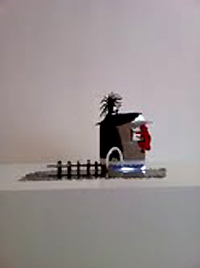 Hu Renyi's "Protection" Hu Renyi's "Protection"
stainless steel, 20 x 7 x 13 cm
2012, courtesy of the artist
|
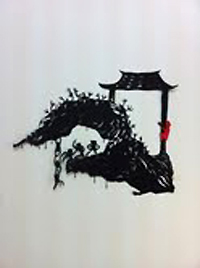 Hu Renyi's "Black Stone" Hu Renyi's "Black Stone"
cutout on paper, 40 x 60 cm
2012, courtesy of the artist
|
| all material © 3 Dots Water 2013 |
|